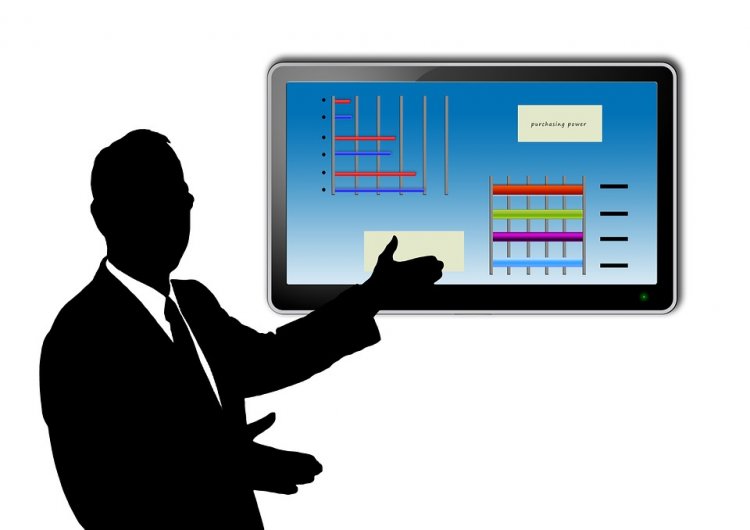Making Your Presentation More Powerful and Meaningful
Ted Frank, Principal Story Strategist, Backstories Studio

With attention spans continuing to shrink, one way we can make our 2017 presentations much more engaging is by taking cues from the place that can still captivate us for hours at a time: movies.
Movie-style storytelling is actually a perfect fit for corporate communication because it’s built on the same principles we’ve all been seeking from presentations all along: being simple, quick, visual and powerful. But the best news is that you can get a lot of movie power without even using video.
A simpler way to get simple
Screenwriters are remarkably quick because they start with just three key scenes, then use them as beacons while building the rest of their story. It works for presentations too. Decide your three most important points first, then use them to guide your story and you’ll stay out of the weeds. Giving them greater emphasis like a movie director would do will also ensure stakeholders remember them––definitely more than if you evenly emphasize 15 points.
Now that you’ve got your key story, take another cue from movies and cut what you don’t need. Hollywood calls it “killing your babies,” but in truth, few in Hollywood kill their own. First, the screenwriter cuts the novel down to 150-or-so pages, then the director cuts it even further, and then finally, the editor gets it down to the story we see on screen.
And you know what: most of the time, we don’t miss those cuts one bit. Because having using less helps us absorb and remember the most important parts of the story.
So grab a colleague close enough to your work to understand it, but far enough from your weed pile. Tell him or her the three key points you want your stakeholders to remember, then ask them to cut anything that gets in the way. In my workshops, I’ve seen people cut 80% from their partner’s deck, and their partners are always, always grateful.
You can do it on the slide level as well. Most charts show dozens of data points, but there’s only one or two that really matter. Emphasize just those and you’ll not only be able to get through the slide more quickly, but can shift the focus to the takeaway that really matters, rather than the minutia.
Make it real
Even when the planet is far away, we can still relate to a movie because the characters, settings and action make it feel real. You can bring that same effect to any slide, even a bar chart, by describing it through an example. After all, every slide is about something happening, or an opportunity for something you recommend to happen. In business, we often turn to drawings or metaphors, but a photograph can make it far more relatable because it comes from something real. It’s also much easier to put together because photos are easy to find.
Make it powerful
There’s a reason movies move us so profoundly. They speak to our emotions. We all know how powerful and persuasive emotions are, yet when we get to the conference room, we forget. But evoking emotions in your stakeholders will inspire them to back you and your initiative.
For instance, create a sense of urgency at the beginning of your presentation and you’ll compel everyone to listen. Movies know this, which is why the “Inciting Incident” is the first key scene. In Star Wars it’s when Luke sees Leia in the hologram. Once he does, he has to save the princess, and we as viewers, share his urgency. Neuroscientists have found these scenes cause our brains to release cortisol, which also intensifies our focus.
As movies continue to push our emotions up their dramatic arcs, they not only keep us riveted for hours (try that with a PowerPoint deck), but also spark the release of another brain chemical, oxytocin, which makes us feel empathy and opens us to new ideas.
And then there’s the emotional magnet they build into nearly every scene: tension. Employ tension in your presentation and you can create those big moments your stakeholders will feel and remember. Anticipation, the hallmark of thrillers, can be raised with a simple pause or provocative question before revealing the key point. Another trick is the “dolly push” shot you see in every love story. The camera moves toward the actors so we emotionally bond with them. As you make your big point, walk slowly toward your stakeholders like a dollied camera and you’ll increase your tension and their bond with you. It’s like a superpower.
These are just a few of the many movie storytelling techniques you can use this year to take your presentation to the next level. I’ll be back in 2018 to help you raise it even more.
[Image courtesy: Geralt/Pixabay]
About the Author
Ted Frank is the principal story strategist at Backstories Studio. His book, Get to the Heart, shows professionals how movie-style storytelling can make their presentations clear, compelling, and c-suite ready. You can find him at ted@backstories.tv or at gettotheheartbook.com

















